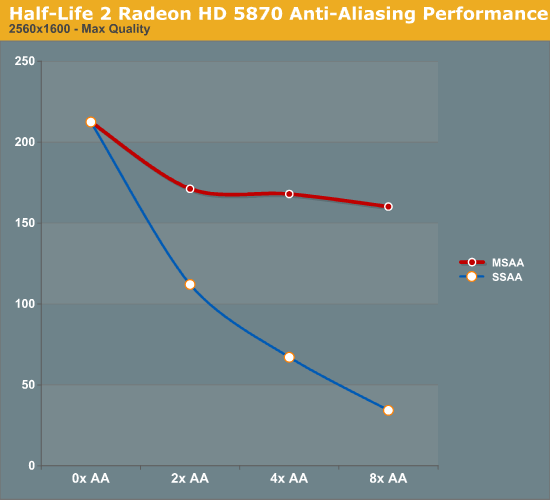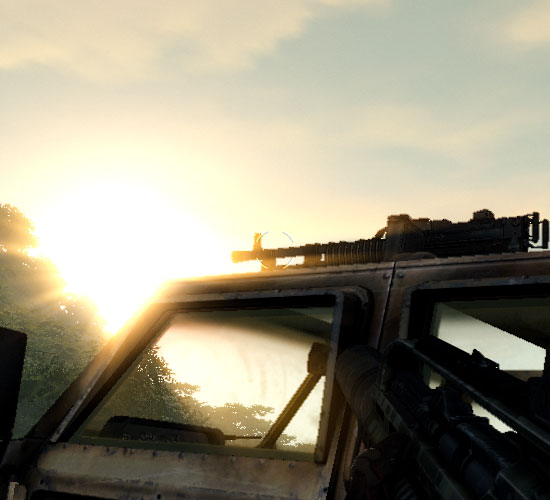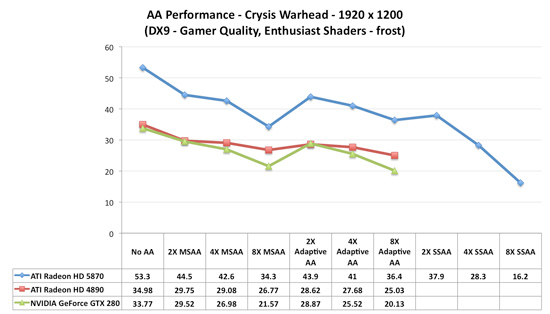AMD's Radeon HD 5870: Bringing About the Next Generation Of GPUs
by Ryan Smith on September 23, 2009 9:00 AM EST- Posted in
- GPUs
AA Image Quality & Performance
With HL2 unsuitable for use in assessing image quality, we will be using Crysis: Warhead for the task. Warhead has a great deal of foliage in parts of the game which creates an immense amount of aliasing, and along with the geometry of local objects forms a good test for anti-aliasing quality. Look in particular at the leaves both to the left and through the windshield, along with aliasing along the frame, windows, and mirror of the vehicle. We’d also like to note that since AMD’s SSAA modes do not work in DX10, this is done in DX9 mode instead.
|
AMD Radeon HD 5870
|
AMD Radeon HD 4870
|
NVIDIA GTX 280
|
| No AA | ||
| 2X MSAA | ||
| 4X MSAA | ||
| 8X MSAA | ||
| 2X MSAA +AAA | 2X MSAA +AAA | 2X MSAA + SSTr |
| 4X MSAA +AAA | 4X MSAA +AAA | 4X MSAA + SSTr |
| 8X MSAA +AAA | 8X MSAA +AAA | 8X MSAA + SSTr |
| 2X SSAA | ||
| 4X SSAA | ||
| 8X SSAA |
From an image quality perspective, very little has changed for AMD compared to the 4890. With MSAA and AAA modes enabled the quality is virtually identical. And while things are not identical when flipping between vendors (for whatever reason the sky brightness differs), the resulting image quality is still basically the same.
For AMD, the downside to this IQ test is that SSAA fails to break away from MSAA + AAA. We’ve previously established that SSAA is a superior (albeit brute force) method of anti-aliasing, but we have been unable to find any scene in any game that succinctly proves it. Shader aliasing should be the biggest difference, but in practice we can’t find any such aliasing in a DX9 game that would be obvious. Nor is Crysis Warhead benefitting from the extra texture sampling here.
From our testing, we’re left with the impression that for a MSAA + AAA (or MSAA + SSTr for NVIDIA) is just as good as SSAA for all practical purposes. Much as with the anisotropic filtering situation we know through technological proof that there is better method, but it just isn’t making a noticeable difference here. If nothing else this is good from a performance standpoint, as MSAA + AAA is not nearly as hard on performance as outright SSAA is. Perhaps SSAA is better suited for older games, particularly those locked at lower resolutions?
For our performance data, we have two cases. We will first look at HL2 on only the 5870, which we ran before realizing the quality problem with Source-engine games. We believe that the performance data is still correct in spite of the visual bug, and while we’re not going to use it as our only data, we will use it as an example of AA performance in an older title.

As a testament to the rendering power of the 5870, even at 2560x1600 and 8x SSAA, we still get a just-playable framerate on HL2. To put things in perspective, with 8x SSAA the game is being rendered at approximately 32MP, well over the size of even the largest possible single-card Eyefinity display.
Our second, larger performance test is Crysis: Warhead. Here we are testing the game on DX9 mode again at a resolution of 1920x1200. Since this is a look at the impact of AA on various architectures, we will limit this test to the 5870, the GTX 280, and the Radeon HD 4890. Our interest here is in performance relative to no anti-aliasing, and whether different architectures lose the same amount of performance or not.
Starting with the 5870, moving from 0x AA to 4x MSAA only incurs a 20% drop in performance, while 8x MSAA increases that drop to 35%, or 80% of the 4x MSAA performance. Interestingly, in spite of the heavy foliage in the scene, Adaptive AA has virtually no performance hit over regular MSAA, coming in at virtually the same results. SSAA is of course the big loser here, quickly dropping to unplayable levels. As we discussed earlier, the quality of SSAA is no better than MSAA + AAA here.
Moving on, we have the 4890. While the overall performance is lower, interestingly enough the drop in performance from MSAA is not quite as much, at only 17% for 4x MSAA and 25% for 8x MSAA. This makes the performance of 8x MSAA relative to 4x MSAA 92%. Once again the performance hit from enabling AAA is miniscule, at roughly 1 FPS.
Finally we have the GTX 280. The drop in performance here is in line with that of the 5870; 20% for 4x MSAA, 36% for 8x MSAA, with 8x MSAA offering 80% of the performance. Even enabling supersample transparency AA only knocks off 1 FPS, just like AAA under the 5870.
What this leaves us with are very curious results. On a percentage basis the 5870 is no better than the GTX 280, which isn’t an irrational thing to see, but it does worse than the 4890. At this point we don’t have a good explanation for the difference; perhaps it’s a product of early drivers or the early BIOS? It’s something that we’ll need to investigate at a later date.
Wrapping things up, as we discussed earlier AMD has been pitching the idea of better 8x MSAA performance in the 5870 compared to the 4800 series due to the extra cache. Although from a practical perspective we’re not sold on the idea that 8x MSAA is a big enough improvement to justify any performance hit, we can put to rest the idea that the 5870 is any better at 8x MSAA than prior cards. At least in Crysis: Warhead, we’re not seeing it.












327 Comments
View All Comments
SiliconDoc - Monday, September 28, 2009 - link
When the GTX295 still beats the latest ati card, your wish probably won't come true. Not only that, ati's own 4870x2 just recently here promoted as the best value, is a slap in it's face.It's rather difficult to believe all those crossfire promoting red ravers suddenly getting a different religion...
Then we have the no DX11 released yet, and the big, big problem...
NO 5870'S IN THE CHANNELS, reports are it's runs hot and the drivers are beta problematic.
---
So, celebrating a red revolution of market share - is only your smart aleck fantasy for now.
LOL - Awwww...
silverblue - Monday, September 28, 2009 - link
It's nearly as fast as a dual GPU solution. I'd say that was impressive.DirectX 11 comes out in less than a month... hardly a wait. It's not as if the card won't do DX9/10.
Hot card? Designed to be that way. If it was a real issue they'd have made the exhaust larger.
Beta problematic drivers? Most ATI launches seem to go that way. They'll be fixed soon enough.
SiliconDoc - Monday, September 28, 2009 - link
Gee, I thought the red rooster said nvidia sales will be low for a while, and I pointed out why they won't be, and you, well you just couldn'r handle that.I'd say a 60.96% increase in a nex gen gpu is "impressive", and that's what Nvidia did just this last time with GT200.
http://www.anandtech.com/video/showdoc.aspx?i=3334...">http://www.anandtech.com/video/showdoc.aspx?i=3334...
--
BTW - the 4870 to 4890 move had an additional 3M core transistors, and we were told by you and yours that was not a "rebrand".
BUT - the G80 move to G92 added 73M core transistors, and you couldn't stop shrieking "rebrand".
---
nearly as fast= second best
DX11 in a month = not now and too early
hot card -= IT'S OK JUST CLAIM ATI PLANNED ON IT BEING HOT !ROFL, IT'S OK TO LIE ABOUT IT IN REVIEWS, TOO ! COCKA DOODLE DOOO!
beta drivers = ALL ATI LAUNCHES GO THAT WAY, NOT "MOST"
----
Now, you can tell smart aleck this is a paper launch like the 4870, the 4770, and now this 5870 and no 5850, becuase....
"YOU'LL PUT YOUR HEAD IN THE SAND AND SCREAM IN CAPS BECAUSE THAT'S HOW YOU ROLL IN RED ROOSERVILLE ! "
(thanks for the composition Jared, it looks just as good here as when you add it to my posts, for "convenience" of course)
ClownPuncher - Monday, September 28, 2009 - link
It would be awesome if you were to stop posting altogether.SiliconDoc - Monday, September 28, 2009 - link
It would be awesome if this 5870 was 60.96% better than the last ati card, but it isn't.JarredWalton - Monday, September 28, 2009 - link
But the 5870 *is* up to 65% faster than the 4890 in the tested games. If you were to compare the GTX 280 to the 9800 GX2, it also wasn't 60% faster. In fact, 9800 GX2 beat the GTX 280 in four out of seven tested games, tied it in one, and only trailed in two games: Enemy Territory (by 13%) and Oblivion (by 3%), making ETQW the only substantial win for the GT200.So we're biased while you're the beacon of impartiality, I suppose, since you didn't intentionally make a comparison similar to comparing apples with cantaloupes. Comparing ATI's new card to their last dual-GPU solution is the way to go, but NVIDIA gets special treatment and we only compare it with their single GPU solution.
If you want the full numbers:
1) On average, the 5870 is 30% faster than the 4890 at 1680x1050, 35% faster at 1920x1200, and 45% faster at 2560x1600.
2) Note that the margin goes *up* as resolution increases, indicating the major bottleneck is not memory bandwidth at anything but 2560x1600 on the 5870.
3) Based on the old article you linked, GTX 280 was on average 5% slower than 9800X2 and 59% faster than the 9800 GTX - the 9800X2 was 6.4% faster than the GTX 280 in the tested titles.
4) Making the same comparisons, 5870 is only 3.4% faster than the 4870X2 in the tested games and 45% faster than the 4890HD.
Now, the games used for testing are completely different, so we have to throw that out. DoW2 is a huge bonus in favor of the 5870 and it scales relatively poorly with CF, hurting the X2. But you're still trying to paint a picture of the 5870 as a terrible disappointment when in fact we could say it essentially equals what NVIDIA did with the GTX 280.
On average, at 2560x1600, if NVIDIA's GT300 were to come out and be 60% faster than the GTX 285, it will beat ATI's 5870 by about 15%. If it's the same price, it's the clear choice... if you're willing to wait a month or two. That's several "ifs" for what amounts to splitting hairs. There is no current game that won't run well on the HD 5870 at 2560x1600, and I suspect that will hold true of the GT300 as well.
(FWIW, Crysis: Warhead is as bad as it gets, and dropping 4xAA will boost performance by at least 25%. It's an outlier, just like Crysis, since the higher settings are too much for anything but the fastest hardware. "High" settings are more than sufficient.)
SiliconDoc - Tuesday, September 29, 2009 - link
In other words, even with your best fudging and whining about games and all the rest, you can't even bring it with all the lies from the 15-30 percent people are claiming up to 60.96%--
Yes, as I thought.
zshift - Thursday, September 24, 2009 - link
My thoughts exactly ;)I knew the 5870 was gonna be great based on the design philosophy that AMD/ATi had with the 4870, but I never thought I'd see anything this impressive. LESS power, with MORE power! (pun intended), and DOUBLE the speed, at that!
Funny thing is, I was actually considering an Nvidia gpu when I saw how impressive PhysX was on Batman AA. But I think I would rather have near double the frame rates compared to seeing extra paper fluffing around here and there (though the scenes with the scarecrow are downright amazing). I'll just have to wait and see how the GT300 series does, seeing as I can't afford any of this right now (but boy, oh boy, is that upgrade bug itching like it never has before).
SiliconDoc - Thursday, September 24, 2009 - link
Fine, but performance per dollar is on the very low end, often the lowest of all the cards. That's why it was omitted here.http://www.techpowerup.com/reviews/ATI/Radeon_HD_5...">http://www.techpowerup.com/reviews/ATI/Radeon_HD_5...
THE LOWEST overall, or darn near it.
erple2 - Friday, September 25, 2009 - link
So what you're saying then is that everyone should buy the 9500 GT and ignore everything else? If that's the most important thing to you, then clearly, that's what you mean.I think that the performance per dollar metrics that are shown are misleading at best and terrible at worst. It does not take into account that any frame rates significantly above your monitor refresh are for all intents and purposes wasted, and any frame rates significantly below 30 should by heavily weighted negatively. I haven't seen how techpowerup does their "performance per dollar" or how (if at all) they weight the FPS numbers in the dollar category.
SLI/Crossfire has always been a lose-lose in the "performance per dollar" category. Curiously, I don't see any of the nvidia SLI cards listed (other than the 295).
That sounds like biased "reporting" on your part.